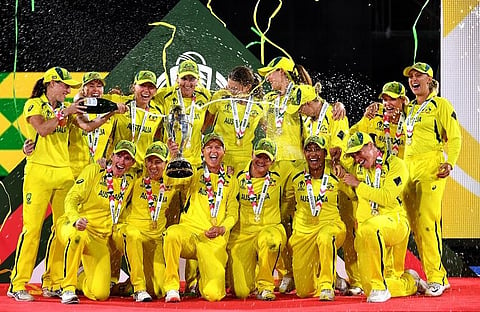

RIDICULOUS.
If there’s a word to describe Meg Lanning’s side from the start of the ODI Championship cycle in 2017 up until the semifinal of the 2022 ODI World Cup, that is it. 39 wins and two defeats in five years: that’s how good they were. And Sunday was expected to be no different. If anything, they took it up a notch, with one of the most ridiculously good batting performances in a World Cup final ever.
Australia’s total of 356 for five, the highest in a Women’s World Cup final, was largely because of one batter — Alyssa Healy, who smashed 170 runs, the second-highest individual score in a World Cup knockout game. It was her rise as a dominant opening batter that marked the start of the Australian dynasty that was established on the ruins of that 2017 World Cup exit.
Healy wants to use the word ‘reinvent’ to define the turn of events, not just for her, but for the team as a whole.
“We came together as a squad and said, this is how we want to play our cricket from now on. And this is — we're going to be the best team in the world and for all 15 people in our squad and I think the girls outside of the squad that have come in and contributed to be able to buy into that has been unbelievable. And I think that's a culture created by the lady sitting next to me (Lanning) and Rach (Rachael Haynes) and Motty (Matthew Mott),” she said after the match on Sunday.
She wasn’t exaggerating. Up until then, Healy was hovering in the middle-order, averaging 15.96 from 52 matches. With the license to play her natural attacking game at the top, she is the leading run-scorer for Australia in the format, averaging 52.29 while striking at 102.29 in the 42 matches since.
And it wasn’t just her. As Healy mentioned a large pool of young players came through the system that is in place, taking to international cricket like fish to water. Case in point: fast bowler Darcie Brown and leg-spinner Alana King. While Brown made her debut last year, King broke onto the scene in January 2022 and had a great debut World Cup, including a three-fer in the final.
“I think the base and platform that we've got in domestic cricket is really strong,” said skipper Lanning, before adding, “the WBBL has played a massive role in setting players up to come into international cricket and perform straightaway and they're under the pump in that competition. They're put in big game situations and that's what's required at a World Cup.”
But is it just about creating the system? Definitely not. Small things like domestic contracts, reducing the wage gap, grassroots pathways, providing the male and female cricketers with similar infrastructure matter. In 2017, Cricket Australia provided female athletes an average pay raise of 125%.
Three years later, for the home T20 World Cup, the cricketing body took it upon itself to ensure that the prize money for the men and women’s events were the same by chipping in an extra US$600,000. Where Australia are right now in world cricket and the ‘winning mentality’ with which they take the field every time — knowing that they would run over any team they are up against — didn't come into being overnight. It's the result of years of investment, exposure and consistency in the selection process.
England aren’t far behind either. To lose the first three games before winning five on the trot to reach the finals doesn’t happen without a system in place. Ask Heather Knight how someone like Charlie Dean came into the set up less than a year ago and owned the big stage, she’d credit the domestic contracts that were introduced in 2020 and the role of The Hundred in helping the off-spinner prepare for pressure situations.
“I think the changes that have been made in the structure back home have really helped, I think it's in a good place. I think things will only improve over the next couple of years. There'll be a few more domestic contracts I imagine and a few more sort of season pros and as high as the standard that we can get that competition as possible… Australia obviously started the domestic setup and the investment in the women's game a little bit earlier than we did. But hopefully it will bear fruit in the next couple of years,” Knight said in the post-match press conference.
Coming back to the final, Natalie Sciver, the extremely talented cricketer that she is, might have played out of her skin to score an unbeaten 148, making the game look like a close contest. But it never really was. Not for one minute did Australia look like a team that could be beaten in this World Cup. While the world celebrated when India ended their 26-match winning streak in September, they have since begun a new streak, notching up 12 wins in a row.
Which is why, when the comparisons arise between Meg Lanning’s side and Ricky Ponting’s Australia of the 2000s, it is more than fair to say that this women’s side is equal to, if not better than, that men’s team with respect to the way they dominate limited-overs cricket. Two T20 World Cups and an ODI World Cup in a span of four years is no mean feat.
What's scary is that the gulf between Australia and the rest could only widen from here. Perhaps, this is a wake-up call for other cricketing bodies to take a good look at what Australia have done behind the scenes to become invincible. They have plenty of catching up to do.